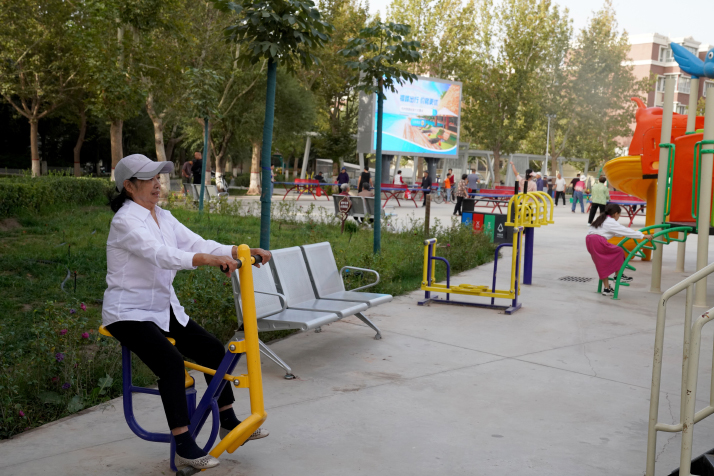| Xinjiang Today |
| A strong safety net | |
|
|
 A local troupe performs during a tourism promotion event in Altay City on May 24 (XINHUA)
Karekezi Muhaimaidi, 80, was happy to meet social security workers at home.
The little group was in a village courtyard in Hami, a city in east Xinjiang famous for its juicy, sweet melons. As the region expands its social security system, they are reaching out to residents, especially senior citizens, to complete the verification process and claim social security. Their presence was a blessing for Karekezi, whose children have left home and she lacks the technological capability to do the verification online on her own. "My children are rarely home, and I don't know how to use a smartphone," she said. Keeping in mind residents like her, the authorities have created the posts of dedicated pension caretakers who visit them monthly with a digital device so that they can check whether their social security allowances are being credited into their accounts. Social security services have come to people's doorsteps in Xinjiang, literally. This is a major transformation over the past 70 years, with Xinjiang witnessing the rapid development of its social security system from scratch to universal coverage. Prior to China's reform and opening up in 1978, Xinjiang followed an enterprise insurance system in which the employer paid for employees' social security. However, as China progressed from a planned economy to a market economy, this traditional model could not keep pace with the demographic changes and the demands of economic reform. The genesis From 1993, China began to establish a pension system combining social coordination—management of employers' contributions and government subsidies—with employees' contributions. The goal was a multi-tiered pension structure to expand social security coverage from urban residents to the entire population. However, due to uneven regional development, varying levels of economic growth and differences in demographic structures, structural imbalances in pension funds developed across provinces. To rectify this, a unified basic pension insurance system for enterprise employees has been launched nationwide. Under this system, surpluses and shortfalls in pension funds began to be adjusted across regions, addressing structural disparities and ensuring sustainable pension payments in less developed areas. For non-enterprise workers, especially rural residents, a unified national pension system has been developed over the past decade. In 2014, the State Council merged the new rural pension scheme with the urban resident pension scheme into a single nationwide system—the basic pension insurance for urban and rural residents, which primarily serves the rural population. Today, rural residents account for 95 percent of the more than 500 million people covered by the system. As the rural social security network continues to improve, the growth in rural residents' income is playing a vital role in supporting the fight against poverty, ensuring that rural residents join the rest of the nation in enjoying a moderately prosperous society.  A quality check at the production line of Ruihai Agricultural Development Co. in Aksu City on March 24, 2024 (XINHUA)
The picture in Xinjiang In Xinjiang, a unified basic pension insurance system for enterprise employees was launched in 1999. Fifteen years later, the rural pension scheme and the urban resident pension scheme were merged to create a unified basic pension insurance throughout the region under national arrangements. Then in 2018, a mechanism to determine pension benefits and regularly adjust the basic pension was introduced. Finally, in 2022, the region's basic pension insurance for enterprise employees was integrated into the national coordination system. As coordination across social insurance programs improves, Xinjiang is working to ensure that everyone is covered. According to a white paper issued in 2021, more than 95 percent of urban and rural residents in Xinjiang are covered by basic pension insurance while unemployment, work-related injury and maternity insurance schemes cover all occupational groups. Last year, over 26 million basic pension, unemployment and work injury insurances were issued in Xinjiang. More than 23 million people were enrolled in the basic medical insurance. As Xinjiang expands its social security system from a modest start to universal coverage, it is building an extensive and resilient social safety net to offer more precise and reliable protection for its residents. In response to the new trends in economic and social development, the region is now improving social security based on sustainable economic and fiscal growth. It continues to refine basic pension benefit adjustments and enhance regional-level coordination for unemployment and work injury insurance. From 2012 to 2024, the monthly basic pension in Xinjiang rose from 72.84 yuan ($10) to 226.87 yuan ($32). The average monthly unemployment benefit increased from 541 yuan ($75) to 1,521 yuan ($211). The average monthly disability allowance grew from 2,307 yuan ($320) to 4,406 yuan ($612). An economic shock absorber Xinjiang's social security system is increasingly serving as a countercyclical stabilizer and economic shock absorber. To stabilize employment, the regional government is paying businesses subsidies to help them retain employees and support new job creation, particularly for graduates and other youth. Since 2023, to invigorate business activity, reduce the burden on enterprises, expand employment and protect livelihoods, Xinjiang has optimized its phased relief policies. The job stabilization refund policy has been continued as well as the skills enhancement subsidy policy. Besides, a one-time job expansion subsidy has been introduced. The job stabilization and expansion subsidies are both disbursed from unemployment insurance funds. These efforts have collectively eased the burden on businesses by 7.5 billion yuan ($1 billion) and ensured their continued growth. Gairui Dairy in Tacheng Prefecture in north Xinjiang is a case in point. Last year, it received 87,300 yuan ($12,100) in job stabilization subsidies and 3,000 yuan ($415) in job expansion grants to cope with market fluctuations.  Residents work out at dawn using the public fitness facilities in a neighborhood in Kashi (Kashgar) City on September 24, 2024 (XINHUA)
Cloud-based convenience With the rapid development of digital and intelligent services, a comprehensive social security service network enables employers and residents to access services online or at multiple service points. Xu Lihua, who retired from China State Construction Xinjiang Engineering Group Co. in February, was amazed at how convenient it was to complete the procedure for his pension. "I had heard it was a real hassle, but after I sent in my application, my company told me to just relax and wait—no need to go to the social security office myself," he said. Xu's application was submitted by his company through Xinjiang's integrated human resources and social security platform. The data was automatically shared across different departments for verification, and in March, his pension was deposited into his social security bank account without any hitch. Xu didn't have to make a single trip to the social security office. In seven decades, following a people-centered development philosophy, Xinjiang's social security system has grown from scratch to universal coverage. Benefits have risen steadily, services have shifted from offline to online, and social welfare has evolved from a basic safety net to a proactive system that ensures the all-round wellbeing of the people. The author is a reporter with the Xinjiang Daily newspaper Comments to liangxiao@cicgamericas.com |
|
||||||||||||||||||||||||||||
|